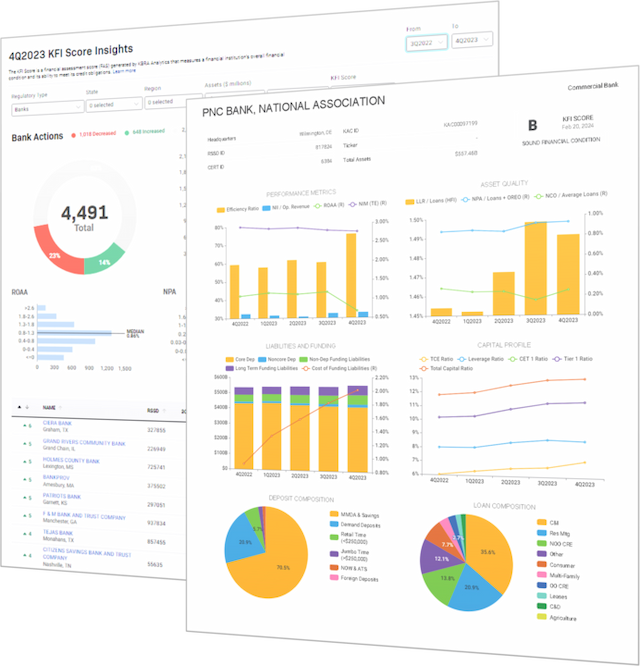KBRA Financial Intelligence
Bank KFI Scores Stabilize After Declines; Brokered Deposits Hit Record
By KFI Staff
KFI Scores for banks stabilized in 4Q 2023 after three cumulative quarterly declines, as banks reported improved capital ratios and an expansion in net interest margins, according to data from KBRA Financial Intelligence (KFI).
In 4Q, increases to banks’ KFI Scores slightly outpaced declines by 474 to 434, with the remaining banks’ rankings unchanged, according to KFI. For the year, declines surpassed increases by 980 to 565 as the fastest rise in interest rates since the 1980s curbed bank profitability.
One of the lenders with a KFI Score increase was Passumpsic Savings Bank, an $850 million lender in northeastern Vermont. In 4Q, the bank posted its best total capital ratio in more than a year and a higher net interest margin, pushing its KFI Score to B from C+.
PASSUMPSIC SAVINGS BANK
Banks with lowered KFI Scores reported, among other things, declines in asset quality. The KFI Score of a $413 million asset community lender in Arkansas, Bank of England, fell to D from B- on an increase in nonperforming loans.
Bank of England
Use the Insights tool on the KFI homepage to analyze Score trends.

From 2010 through 2023, more than 96% of banks that failed had a KFI Score of D or lower prior to the FDIC date of failure, according to KFI data.
KFI Scores measure the financial health of all U.S. banks and credit unions quarterly on an A through E scale, using a proprietary quantitative model. D scores signify a “relatively weak” financial condition, while an E ranking conveys a "poor" financial condition, based on KFI’s methodology.
Brokered Deposits Reach Record $1.35 Trillion
Brokered deposits reached a record $1.35 trillion at the end of 2023, more than doubling since 1Q 2022 when the Federal Reserve started hiking interest rates.

The amount of brokered deposits to total deposits has climbed to 7.16% in 4Q 2023, up from 2.99% in 1Q 2022, according to data compiled by KFI. During the pandemic, banks largely eschewed the funding source, as they were awash in deposits from government stimulus programs. The rapid rise in interest rates has pushed brokered deposits back to pre-pandemic trendlines.
Regional lenders ($10 billion to $100 billion) reported the biggest increase in brokered deposits during the period (See table below).
KFI Pro subscribers can analyze brokered deposit trends by using the following Data IDs:
Total Brokered Deposits: KBRA2365 Brokered Deposits to Total Deposits: KCALLBKDTD
In Case You Missed It
We released our bank 4Q 2023 snapshot reports for the biggest banks as well as regional and community lenders. The snapshots compare lenders across five financial metrics: ROAA, NPA, Tier 1 capital, cost of total funding, and delinquent loan ratio.
M&A
Hometown Financial Group Inc., a multibank holding company, agreed on February 15 to buy North Shore Bancorp. (KFI Score: B+) for an undisclosed price. The combined bank will have more than $3 billion in assets and 25 branches across Massachusetts and southern New Hampshire. The deal marks the seventh merger for Hometown Financial Group in the last nine years, according to the press release.
The $1.9 billion Empeople Credit Union in Moline, Illinois (KFI Score: B+), agreed on February 7 to buy virtually all of the assets of $182 million TSB bank in Lomira, Wisconsin (KFI Score: B+), for an undisclosed price. The deal, which is expected to be completed by the fourth quarter, will create a $2.2 billion lender.
3 Things in Credit Podcast
Follow KBRA’s weekly podcast and newsletter 3 Things in Credit, hosted by our Chief Strategist, Van Hesser. From the February 23 episode:
“Let’s start with the banking system. There is lots of misinformation out there, driven by a rush to publish views by opinion makers, be it by journalists, sell-side shops, or academic researchers. All are guilty. Here are some facts.
Banks are big lenders on CRE, but collectively they account for just 38% of the $4.6 trillion of loans to the sector, according to the Mortgage Bankers Association. Sources well regarded by some have put this number at 70%. Simply not true.”
